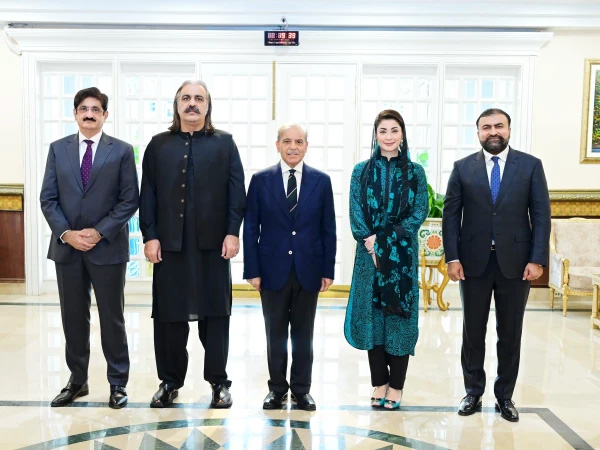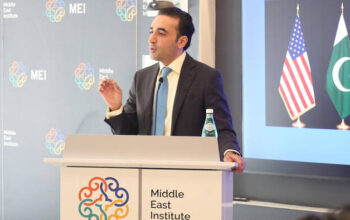By Staff Reporter
ISLAMABAD: The National Economic Council (NEC) on Wednesday approved a record Rs4.22 trillion national development outlay for the next fiscal year, fueled by a 22% increase in provincial allocations.
The move aims to lift the economic growth rate to 4.2% from 2.7% this year, despite a 29% cut in the public sector development program (PSDP) mandated by the International Monetary Fund (IMF).
Dawn newspaper reported that the provincial expansionary stance is likely to draw scrutiny from the IMF, which has been pressing for larger provincial cash surpluses to bolster the federal government’s debt servicing capacity and push for effective taxation of agricultural income under a new national fiscal pact.
The NEC meeting, Pakistan’s highest economic decision-making body, was chaired by Prime Minister Shehbaz Sharif and rescheduled a day earlier to accommodate his overseas travel. All provincial chief ministers, the deputy prime minister, federal ministers for planning, finance, and information, and the prime minister’s adviser Rana Sanaullah attended.
“This budget sets the stage for sustainable progress,” Sharif said during the meeting, emphasising collaboration between federal and provincial authorities. The NEC’s six-point agenda, along with macroeconomic targets for FY26, won unanimous approval, with directives issued to ministries and provinces to align efforts with the Ministry of Planning.
“The country is now on the path to economic growth,” Sharif told the council, spotlighting agriculture as a cornerstone of rising national reserves. “A strategy is being formulated for a gradual increase in agricultural production,” he added.
A performance report for FY25 underscored the momentum: Rs3.483 trillion was spent on the Annual National Development Programme, with Rs1.1 trillion for federal projects and Rs2.383 trillion for provinces. The GDP growth rate for FY25 was pegged at 2.7%, with an ambitious 4.2% target set for FY26. The economy is projected to hit Rs114 trillion ($411 billion) in FY25.
Other metrics painted a rosy picture. Remittances surged 30.9% from July 2024 to April 2025, while the current account balance flipped to a surplus. The fiscal deficit shrank to 2.6% of GDP, and the primary balance posted a 3% surplus. The policy rate eased to 11%, spurring private-sector loans to climb to Rs681 billion over the 10 months through May 2025.
Development Budget
The development portfolio includes Rs1 trillion from the PSDP, Rs2.869 trillion from provincial annual development plans (ADPs), and Rs355 billion for state-owned enterprise (SOE) projects funded through their own resources.
The federal government allocated Rs880 billion for the PSDP, down 20% from the current year’s revised allocation of Rs1.1 trillion and 37% below the original Rs1.4 trillion plan. To reach the Rs1 trillion PSDP figure, the government added Rs120 billion raised through a petroleum levy introduced last month, earmarked for projects in Balochistan.
Provincial allocations jumped 22% from Rs2.358 trillion this year. Two days earlier, at the Annual Plan Coordination Committee (APCC) meeting, provinces had proposed Rs2.795 trillion for their ADPs, but they revised this upward to Rs2.869 trillion for the next fiscal year.
Punjab spearheads the development push with a record Rs1.204 trillion ADP, up 10.6% from Rs1.089 trillion this year and 20% higher than the federal PSDP allocation. This marks the first time a province has outstripped the Centre’s development spending, underscoring the growing financial heft of the federating units.
Sindh follows with Rs967 billion, a 27% increase from Rs705 billion, boosting its initial APCC proposal by Rs80 billion. Khyber Pakhtunkhwa (KP) set its ADP at Rs417 billion, a 33% rise from Rs313 billion, though it trimmed its APCC figure by Rs23 billion from Rs440 billion. Balochistan, heavily reliant on federal support, allocated Rs281 billion, up 12% from Rs252 billion.
SOE project estimates also rose to Rs355 billion from Rs288 billion proposed at the APCC. Despite the provincial windfall, Sindh and KP chief ministers voiced frustration over the exclusion of their projects from the federal budget. Balochistan’s chief minister, however, thanked the Centre for its special focus on the province. KP’s finance adviser, Muzammil Aslam, acknowledged the federal government’s constraints, saying they were understandable “in the given circumstances.”
The cash-strapped federal government safeguarded Rs50 billion for coalition partners’ parliamentarians scheme and boosted funding for the Pakistan Muslim League-Nawaz’s (PML-N) signature road-building projects. Meanwhile, sectors like energy, food, and water, along with special areas such as Azad Kashmir and Gilgit-Baltistan, face funding squeezes.
Copyright © 2021 Independent Pakistan | All rights reserved




